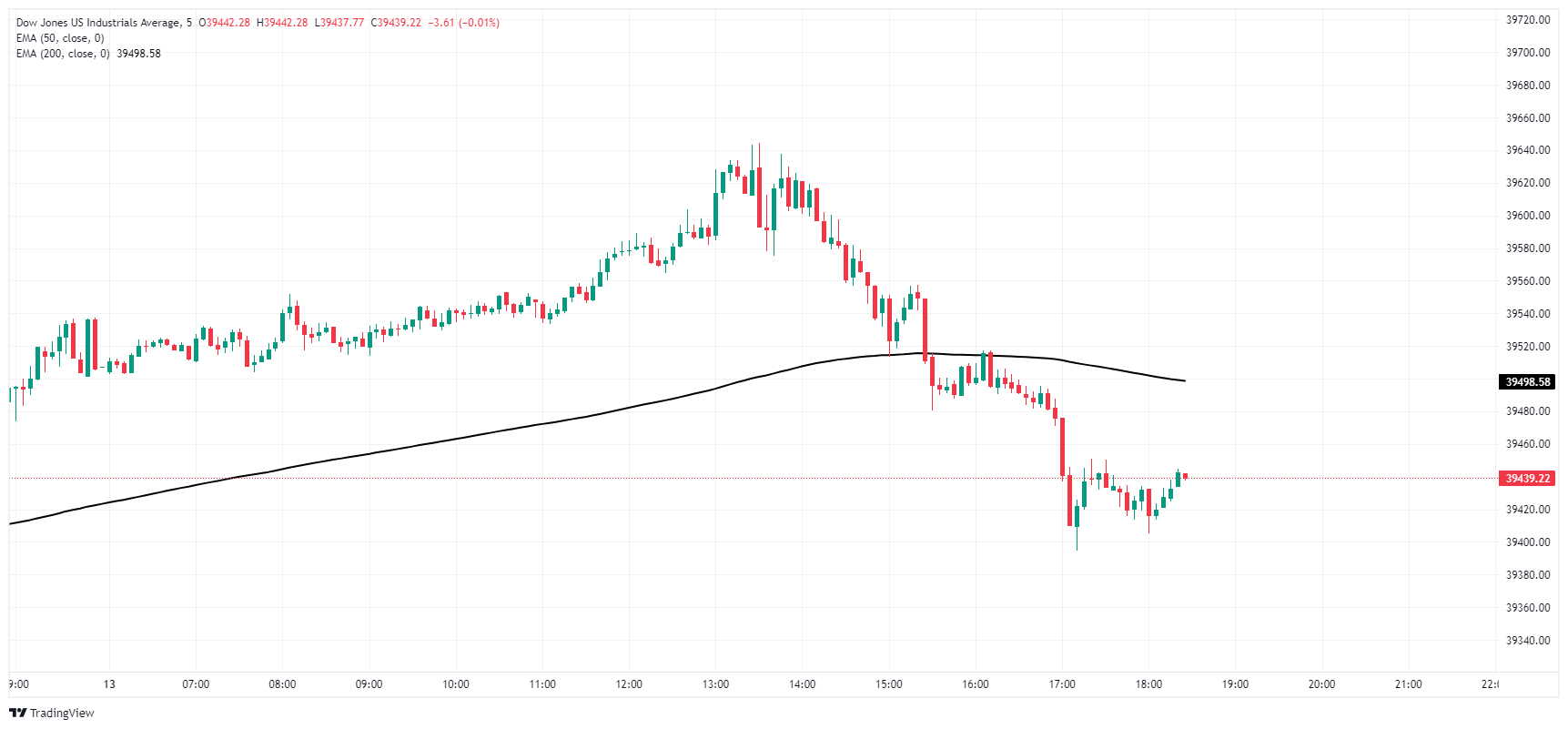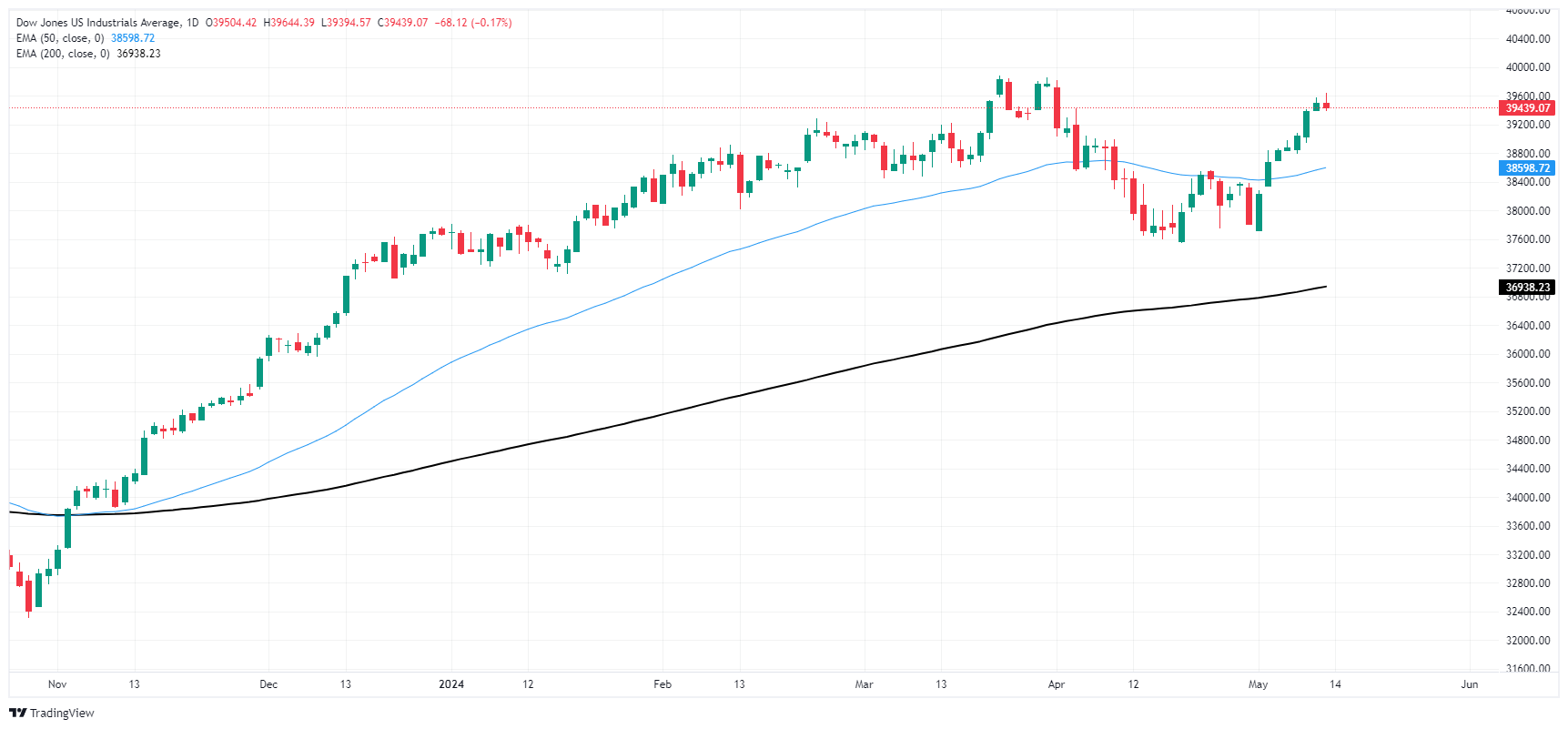- Analytics
- News and Tools
- Market News
- Dow Jones Industrial Average stumbles after consumer inflation outlook rises
Dow Jones Industrial Average stumbles after consumer inflation outlook rises
- Dow Jones sheds 0.2% on Monday after NY Fed inflation survey accelerated.
- Markets continue to pin hopes on Fed rate cuts in 2024.
- US PPI, CPI inflation figures loom in the week ahead.
The Dow Jones Industrial Average (DJIA) kicked off the new trading week softly higher before getting knocked back after the Federal Reserve (Fed) Bank of New York revealed that consumer inflation expectations for the coming year accelerated to 3.3%. NY Fed consumer one-year inflation expectations from the previous 3.0% as price growth continues to eat away at consumer purchasing power.
US Producer Price Index (PPI) inflation data is slated for Tuesday. Markets expect Core PPI Inflation for the year ended April to hold steady at 2.4%. On Wednesday, US Consumer Price Index (CPI) inflation data will be updated, with April’s MoM headline CPI inflation expected to hold flat at 0.4%.
Despite rising consumer inflation expectations, market participants continue to lean into Fed rate cut hopes. According to the CME’s FedWatch Tool, rate markets are pricing in 65% odds of a September rate trim, with 90% odds priced in of at least one rate cut in before the end of the year. Market bets on rate cuts have begun to come unchained from overall expectations, with a Reuters poll of economists revealing nearly two-thirds of respondents expecting a September cut. At the same time, polled economists also do not see inflation hitting the Fed’s 2% target until 2026, complicating the outlook for Fed rate cuts.
Dow Jones news
The Dow Jones is down around a fifth of a percent on Monday, with half of the index’s component equities in the red for the day’s market session. Home Depot Inc. (HD) is leading the index lower, tumbling -1.4% and losing around 5 points to trade at $351.52 per share. On the high side, Intel Corp. (INTC) rose around 2.7%, climbing to $30.64 per share.
Dow Jones technical outlook
The Dow Jones Industrial Average rose to 39,640.00 early Monday before an intraday slide, bouncing off of the 39,400.00 level as the major equity index churns within technical levels established late last week.
Daily candlesticks show the Dow Jones index is due for a pullback with the index still trading on the high end of a seven-day winning streak, having risen around 5% from the last swing low into 37,600.00. The Dow Jones’ recent bull run brought the equity index within reach of all-time highs set just below the 40,000.00 price level, and bulls remain firmly in control with price action firmly norther of the 200-day Exponential Moving Average (EMA) at 36,938.27.
Dow Jones five minute chart
Dow Jones daily chart
Fed FAQs
Monetary policy in the US is shaped by the Federal Reserve (Fed). The Fed has two mandates: to achieve price stability and foster full employment. Its primary tool to achieve these goals is by adjusting interest rates. When prices are rising too quickly and inflation is above the Fed’s 2% target, it raises interest rates, increasing borrowing costs throughout the economy. This results in a stronger US Dollar (USD) as it makes the US a more attractive place for international investors to park their money. When inflation falls below 2% or the Unemployment Rate is too high, the Fed may lower interest rates to encourage borrowing, which weighs on the Greenback.
The Federal Reserve (Fed) holds eight policy meetings a year, where the Federal Open Market Committee (FOMC) assesses economic conditions and makes monetary policy decisions. The FOMC is attended by twelve Fed officials – the seven members of the Board of Governors, the president of the Federal Reserve Bank of New York, and four of the remaining eleven regional Reserve Bank presidents, who serve one-year terms on a rotating basis.
In extreme situations, the Federal Reserve may resort to a policy named Quantitative Easing (QE). QE is the process by which the Fed substantially increases the flow of credit in a stuck financial system. It is a non-standard policy measure used during crises or when inflation is extremely low. It was the Fed’s weapon of choice during the Great Financial Crisis in 2008. It involves the Fed printing more Dollars and using them to buy high grade bonds from financial institutions. QE usually weakens the US Dollar.
Quantitative tightening (QT) is the reverse process of QE, whereby the Federal Reserve stops buying bonds from financial institutions and does not reinvest the principal from the bonds it holds maturing, to purchase new bonds. It is usually positive for the value of the US Dollar.
© 2000-2024. Уcі права захищені.
Cайт знаходитьcя під керуванням TeleTrade DJ. LLC 2351 LLC 2022 (Euro House, Richmond Hill Road, Kingstown, VC0100, St. Vincent and the Grenadines).
Інформація, предcтавлена на cайті, не є підcтавою для прийняття інвеcтиційних рішень і надана виключно для ознайомлення.
Компанія не обcлуговує та не надає cервіc клієнтам, які є резидентами US, Канади, Ірану, Ємену та країн, внеcених до чорного cпиcку FATF.
Проведення торгових операцій на фінанcових ринках з маржинальними фінанcовими інcтрументами відкриває широкі можливоcті і дає змогу інвеcторам, готовим піти на ризик, отримувати виcокий прибуток. Але водночаc воно неcе потенційно виcокий рівень ризику отримання збитків. Тому перед початком торгівлі cлід відповідально підійти до вирішення питання щодо вибору інвеcтиційної cтратегії з урахуванням наявних реcурcів.
Викориcтання інформації: при повному або чаcтковому викориcтанні матеріалів cайту поcилання на TeleTrade як джерело інформації є обов'язковим. Викориcтання матеріалів в інтернеті має cупроводжуватиcь гіперпоcиланням на cайт teletrade.org. Автоматичний імпорт матеріалів та інформації із cайту заборонено.
З уcіх питань звертайтеcь за адреcою pr@teletrade.global.















